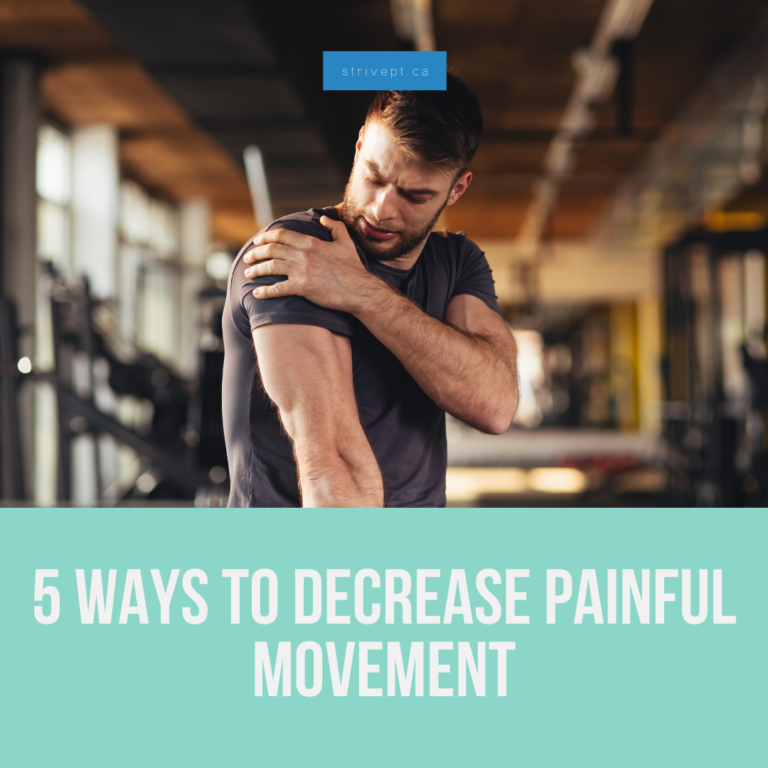
When you have an injury, decreasing the amount of pain you are experiencing is often at the forefront of your mind!
For physiotherapists, we are considering MANY factors in your recovery: your range of motion, the strength of your muscles, getting you back to work/your sport, and preventing future injuries.
However, we recognize that uncontrolled pain can be a barrier to achieving these goals.
Physiotherapists (and other health care practitioners you may have seen) can do many different techniques in order to reduce the pain that you experience with movement.
Two different health care practitioners may do completely different treatment techniques, and both may have the same effectiveness in reducing pain with movement.
It is important to keep in mind that these techniques help you move more easily, which helps your injury heal.
Your physiotherapist will walk you through exactly what type of movement will be the best to help your specific injury recover.
Before we get started, let’s review the basics.
What is pain?
In your body, you have receptors that tell your brain information about what is going on.
There are receptors that collect information about temperature, stretch, and chemicals (among other things!), and send that information via nerves up to the brain to decide what all that information means.
Do you know where your pain receptors are?
…They don’t exist.
That is because pain is actually an OUTPUT.
Your brain collects a massive amount of information and uses all the information at its disposal to create an output of a painful sensation if it decides there is a threat to your body.
This is a good thing in a lot of cases – this sensation tells you something is wrong and to do something about it! It will help prevent the situation below:
EXAMPLE
If you get an ankle injury while you’re playing soccer, the pain the you get at the time of injury will prompt you to sit out of your soccer game, therefore preventing any further injury to your ankle.
As you progress through your recovery process, your brain also will use lots of seemingly unrelated information to create that output of pain.
Have you had a super stressful day and are pulling your hair out? You may find that your pain is a little worse.
Are you having a zen, calming, sunshine and rainbows day? You may find that your symptoms aren’t so bad.
Check out the chart below for more things that can impact your pain level! The effect of each part of the pie is different for everybody.
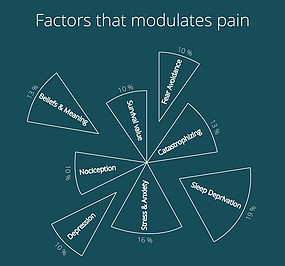
Does pain sound really complex? It is! Because of the complicated nature of pain, there are lots of factors that could make your pain worse, but also lots of ways to improve your pain!
Here are 5 “tricks” that physiotherapists can use to help decrease the pain you have with movement – and I’m going to explain each one!
1) IASTM
IASTM stands for Instrument Assisted Soft Tissue Mobilization.
You may have seen the physiotherapists at Strive Physiotherapy & Performance using this crazy looking tool:
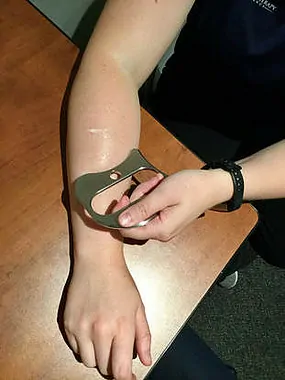
This is a stainless steel tool which physiotherapists can use to GENTLY scrape the skin over areas that are painful.
At Strive Physiotherapy & Performance, we use this treatment in a way that does not cause bruising or skin irritation.
This provides a novel input into your nervous system that is not a danger to your body.
It’s going to fire off more receptors in the area to send feedback to your brain.
This helps to decrease the level of threat in your nervous system. More specifically, effects can include improving your brain’s awareness of where your body is in space, and reducing muscle tone.
This is a very gentle treatment that can be used on many areas of the body (whether it’s a small or large area!).
2) Cupping There is a type of cupping that uses fire underneath the cups – but don’t worry, we don’t do this type of cupping!
The type of cupping done at Strive Physiotherapy & Performance is with a soft silicone cup. Check out the video below!
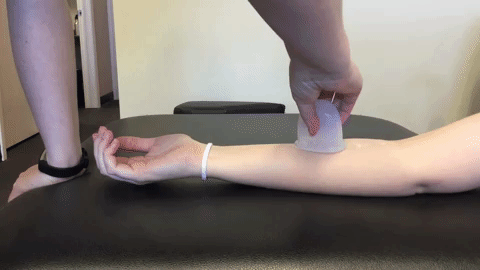
The cup is squeezed gently and then applied to the skin with a little bit of cream to create a gentle suction force.
Then the cup is slid along the skin in the areas we are looking to reduce pain in – typically over muscles.
By keeping the cup moving, it is less likely to create a bruise mark underneath the cup.
While there are different sizes of cups for different areas of the body,
This treatment will be more effective on more flat surfaces so that it doesn’t lose suction (ie. probably not your finger or over very bony areas!).
Instead of a force being applied into the tissues (like in massage), this treatment provides a “suction” force. This can increase blood flow and stimulate your nervous system to decrease the pain of movement.
3) Heat
Moist heat is a treatment that can be helpful to warm muscles up, and help decrease the amount of pain in the area.
It also helps to increase blood flow! This has a number of great effects including bring more oxygenated blood to muscles.
Just like any of our other treatments, it also has an effect on your nervous system. It’s an input into your nervous system that is safe and comforting, which can reduce the output of pain. 10-15 minutes can do the job.
The heat should always feel comfortable, and never so hot that it’s painful! Our hot packs at the clinic sit in a hot water tank – that’s how they stay toasty warm!
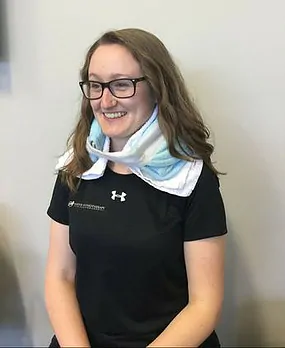
4) Compression bands
One way to help movement feel better for your joints is to wear a compression sleeve.
While this works really well for some areas of your body, other areas may benefit from some compression too!
We can use a compression band in order to provide a “hug” to your limb, and then move your limb.
Again, this gives more information for your receptors to collect and send to your brain, therefore reducing the output of pain or the sensation of stretching/pulling you feel. Take a look at the video below!

5) Movement!
One of the MOST IMPORTANT techniques that physiotherapists use to help movement feel better is just that : more movement!
While you may find that “everything hurts”, usually we can find a movement that either doesn’t hurt, or hurts less the more you do it!
Our bodies are very responsive to movement throughout our day. If we move too much, our brain may respond as if a threat is posed to our body.
This level of threat can already be really high if you already have an injury, and therefore movements which normally feel good may be painful.
However, if we don’t move at all, our body gets used to not moving, and you may be able to move even less! You often hear people say
“just rest up and you’ll get better” –
this usually isn’t true for most musculoskeletal injuries.
“Relative rest” is the better way to rest. This means that you are perhaps taking a break from higher activity levels that are aggravating your symptoms, but keeping all the movement that doesn’t aggravate your symptoms, and also adding in some extra movements that are going to facilitate your recovery the best.
Does this sound complicated? Don’t worry, this is what physiotherapists love to do! Physiotherapists will tell you what to do, what not to do (for now!), and what movements you will be working towards getting back to.
And this can change over time! The movements you are working on this week may be super easy next week.
Then you’re ready to progress to the next stage of exercise. A progressive exercise program over time will ensure you continue challenging your body to be able to do more.
While it can seem like some of the treatments physiotherapists or other health care practitioners use are “magic”, there should be scientific research or a biological mechanism through which the treatment works.
It’s “magic” or “it just works” is not a good enough answer! Not clear on what a treatment you’re getting is doing?
Just ask!
The more you know, the better you can understand your recovery process.
These are just some of the many treatment options there are to reduce pain with movement.
Your therapist may choose different treatments depending on the person, the injury, and the stage of your recovery.
These treatments are also often TEMPORARY. They can create a “window of opportunity” to get you moving more easily, but if you don’t take advantage of that window, you may find that you’re back where you started. The most important lesson here is to get moving.
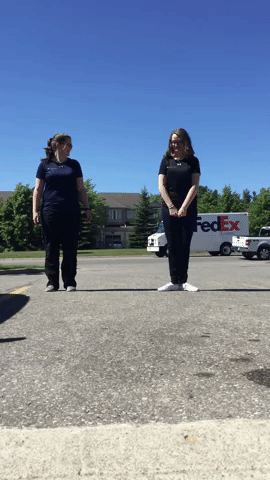
Do you have painful movement that won’t go away?
Call us at 519-895-2020, or use our online booking tool on www.strivept.ca to book an appointment with one of our knowledgeable physiotherapists, and they will perform an assessment and create a treatment plan for you. Cheers, Amanda McFadden Physiotherapist at Strive Physiotherapy & Performance.
